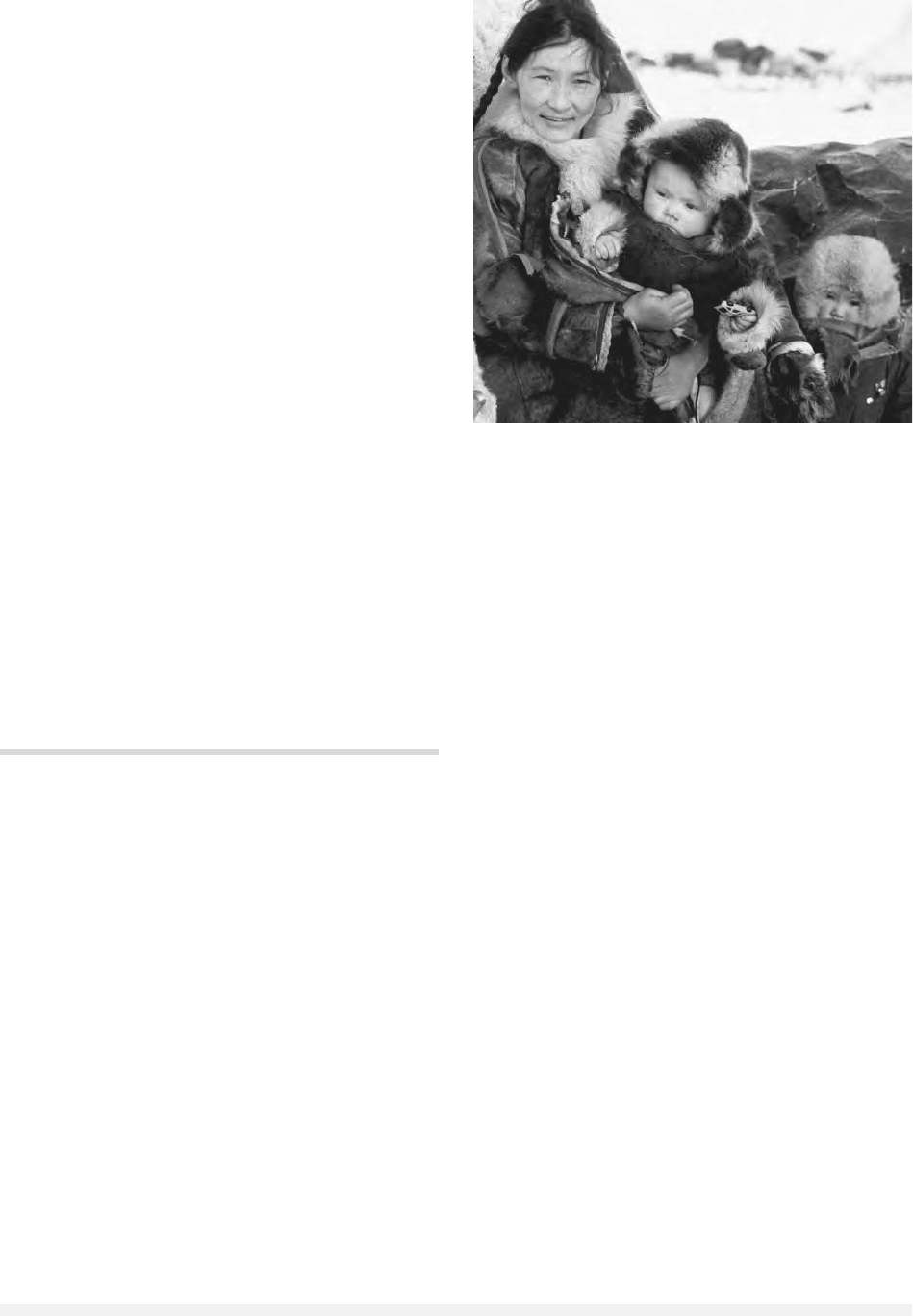Encyclopedia of Russian History
Подождите немного. Документ загружается.


ans admired him as a Bolshevik type. In the period
of glasnost and after, Russian writers saw in
Nechayev a forerunner of Stalin and other patho-
logically destructive dictators.
See also: BAKUNIN, MIKHAIL ALEXANDROVICH; DOS-
TOYEVSKY, FYODOR MIKHAILOVICH; HERZEN, ALEXAN-
DER IVANOVICH; TERRORISM
BIBLIOGRAPHY
Avrich, Paul. (1974). Bakunin and Nechaev. London: Free-
dom Press.
Pomper, Philip. (1979). Sergei Nechaev. New Brunswick,
NJ: Rutgers University Press.
Prawdin, Michael [Charol, M.]. (1961). The Unmention-
able Nechaev. New York: Roy Publishers.
Venturi, Franco. (1960). Roots of Revolution. New York:
Knopf.
P
HILIP
P
OMPER
NEKRASOV, NIKOLAI ALEXEYEVICH
(1821–1878), one of Russia’s most famous poets.
Painfully aware of the injustice of serfdom,
Nikolai Nekrasov (the “master poet of the peasant
masses”) was the first poet to make the “People”
(narod) the focal point of his poetry—especially the
downtrodden, who became the symbol of national
suffering and exploitation. In one of his master-
pieces, the satiric folk epic Who Can Be Happy and
Free in Russia? (written between 1873 and 1877),
seven peasants try endlessly to guess the answer
to the question in the title. Nekrasov also served
for thirty years as editor of Sovremenik (The Con-
temporary), a journal he bought in 1847. Ivan Tur-
genev, Alexander Herzen, Vissarion Belinsky, and
Fyodor Dostoevsky gladly sent their writings to
him, and soon Nekrasov became a leading intellec-
tual figure of the time. Censorship was at its height
at the beginning of his career, intensified by the
French Revolution of 1848 and later the Crimean
War (1854–1856), and Nekrasov was only able to
write freely after the death of Nicholas I and the
accession of the liberal Alexander II.
The decade from 1855 to 1865 was one of the
bright periods in Russian literature. Serfdom was
abolished (1861), Sovremenik’s readership steadily
increased, and Nekrasov published some of his
finest poems, including “The Peasant Children,”
“Orina, the Mother of a Soldier,” “The Gossips,”
“The Peddlers,” and “The Railway.” Some contem-
poraries criticized Nekrasov for his didacticism and
prosiness. The enthusiastic response of radical rev-
olutionaries to his poetry confirmed their suspicion
that he was primarily a propagandist. But
Nekrasov, as he wrote to Leo Tolstoy, believed that
the role of a writer was to be a “teacher” and a
“representative for the humble and voiceless.”
Nekrasov’s empathy for the poor and oppressed
stemmed from his life experiences. He was the son
of a noble family that had lost its wealth and land.
His father, an officer in the army, had eloped with
the daughter of a Polish aristocrat, inducing her to
give up her wealth. The couple settled in Yaroslav
Province on the Volga River, where the young
Nekrasov could hear and see convicts pass on their
way to Siberia. His father, who had become the lo-
cal police chief, often took Nekrasov with him on
his rounds, during which the boy heard the con-
descending way he spoke to peasants and witnessed
the cruel corporal punishments he inflicted on
them. When Nekrasov was seventeen, his father
sent him to St. Petersburg to join the army, cut-
ting off his funds when he disobeyed and tried to
enter the university instead. It took the poet three
years of near-starvation before he could make
enough money from his writing to survive.
See also: GOLDEN AGE OF RUSSIAN LITERATURE; POPULISM
BIBLIOGRAPHY
Birkenmayer, Sigmund S. (1968). Nikolaj Nekrasov: His
Life and Poetic Art. Paris: Mouton.
Kates, J. (1999). In the Grip of Strange Thoughts: Russian
Poetry in a New Era. Brookline, MA: Zephyr Press.
Peppard, Murray B. (1967). Nikolai Nekrasov. New York:
Twayne.
Smith, Vassar W. (1996). Lermontov’s Legacy: Selected Po-
ems of Eight Great Russian Poets, with Parallel Texts
in English Verse Translation. Palo Alto, CA: Zapad
Press.
J
OHANNA
G
RANVILLE
NEMCHINOV, VASILY SERGEYEVICH
(1894-1964), Soviet statistician, mathematical
economist, and reformer.
Though originally trained as a statistician,
Nemchinov became one of the most versatile and
productive members of the Soviet economics es-
NEMCHINOV, VASILY SERGEYEVICH
1033
ENCYCLOPEDIA OF RUSSIAN HISTORY

tablishment. During the early period of his career,
his specialty was agricultural economics and sta-
tistics, on which he published a number of impor-
tant theoretical works. He developed methods for
measuring livestock herds and grain harvests from
aerial observations, which were intended to remove
human error but led ironically to the scandalous
exaggeration of Soviet grain harvests. In 1940 he
became director of the Timiryazev Agricultural
Academy in Moscow. He was elected academician
of the Belorussian Academy of Sciences in 1940,
and of the USSR Academy of Sciences in 1946.
Nemchinov was often in political trouble. In
1948, in the struggle with Trofim Lysenko over
genetics, he harbored a number of modern geneti-
cists in the Timiryazev Academy and defended them
against the Lysenko forces. As a result, he was
forced out as Academy director and was even re-
moved from his position in the statistics depart-
ment. He went home to await arrest, but the Soviet
Academy of Sciences stood by him, and he was ap-
pointed chairman of a new Council on Productive
Forces. He remained an important figure in the
Academy, holding, for example, the position of
academician-secretary of the department of eco-
nomic, philosophical, and legal sciences from 1954
to 1958.
The final phase of his career centered on the in-
troduction of mathematical methods into Soviet
economics. In 1958, he organized in the Academy
of Sciences the first laboratory devoted to the
application of mathematical methods in econom-
ics, which later became the Central Economic-
Mathematical Institute. He was the driving force in
setting up the first conference on mathematical
methods in economic research and planning in
1960. He headed the scientific council on the use
of mathematical methods and computer technol-
ogy in economic research and planning in the Acad-
emy and organized the faculty of mathematical
methods of analysis of the economy at Moscow
State University. His role in developing linear pro-
gramming methods and economic models was re-
warded posthumously in 1965 by the conferral of
the Lenin Prize.
See also: ACADEMY OF SCIENCES; LYSENKO, TROFIM
DENISOVICH
BIBLIOGRAPHY
Nemchinov, Vasilii. (1964). Use of Mathematics in Eco-
nomics. Edinburgh: Oliver and Boyd.
R
OBERT
W. C
AMPBELL
NEMTSOV, BORIS IVANOVICH
(b. 1959), prominent liberal politician and leader of
the Union of Right Forces.
Born in Sochi, Boris Ivanovich Nemtsov re-
ceived a doctorate in physics in 1990. From 1990
to 1993 he was a member of the Congress of Peo-
ple’s Deputies, serving on the Council for Legisla-
tive Affairs. In 1991 President Boris Yeltsin made
him the governor of Nizhny Novgorod.
Nemtsov quickly moved to transform the
province into a cutting-edge experiment in free-
market economics. Obtaining a license to open a
business in post-communist Russia plunged
would-be entrepreneurs into a nightmare of bu-
reaucratic corruption. Nemtsov made it possible to
register new businesses by mail, and allowed the
project to go forward if the petitioner received no
answer within a reasonable amount of time.
Equally innovative in agricultural affairs, Nemtsov
enabled members of collective farms to acquire in-
dividual plots, and he introduced tax breaks for
struggling businesses. To deal with the inefficient
Soviet practice whereby industrial enterprises had
to provide housing and other social services for em-
ployees, the new governor encouraged companies
to raise wages instead so that their workers could
afford to pay for rent and utilities. These policies
and Nemtsov himself proved immensely popular,
and he was elected governor outright in 1995, re-
ceiving 60 percent of the vote. Nemtsov was so
popular, in fact, that the Yeltsin camp of reform-
ers briefly considered running him for president in
1996 against the communist Gennady Zyuganov.
Nothing came of this, but in 1997, after Yeltsin’s
reelection, Nemtsov reluctantly accepted the office
of first deputy prime minister.
In Moscow Nemtsov and his colleagues
launched a program of economic “shock therapy.”
The new deputy minister was charged with mak-
ing bidding for government contracts more open
and competitive, forcing railroads and electricity
suppliers to cut their prices, reducing household
utility rates by 30 percent, and overhauling the
Pension and Securities Insurance Fund. Little won-
der Nemtsov called his job “politically suicidal”
(Aron, 2000, p. 367).
Nemtsov began by making all government
contracts valued at more than 900 million rubles,
including military contracts, subject to competitive
bidding. He then plunged into the state’s sale of
25 percent of Svyazinvest, the national telecom-
NEMTSOV, BORIS IVANOVICH
1034
ENCYCLOPEDIA OF RUSSIAN HISTORY

munications enterprise. Nemtsov publicly declared
that the sale would be a national test of the gov-
ernment’s ability to take on the notorious “oli-
garchs” who had looted many of Russia’s assets in
the years after communism.
The losers in the bidding for Svyazinvest used
their media outlets to open a blistering campaign
against the government, but more serious was a
sharp drop in global oil prices, a vital source of gov-
ernment income. Simultaneously a financial crisis
that had begun in Asia spread to Russia, causing
investors to flee from emerging market economies.
By the spring of 1998 Russia was on the verge of
economic collapse, and in March Yeltsin dismissed
his entire cabinet, including Nemtsov. The follow-
ing year Nemtsov was elected to the Duma of the
Russian Federation.
See also: BUREAUCRACY, ECONOMIC; KIRIYENKO, SERGEI
VLADILENOVICH; PRIVATIZATION; SHOCK THERAPY;
YELTSIN, BORIS NIKOLAYEVICH
BIBLIOGRAPHY
Aron, Leon. (2000). Yeltsin: A Revolutionary Life. London:
HarperCollins.
Talbott, Strobe. (2002). The Russia Hand: A Memoir of
Presidential Diplomacy. New York: Random House.
H
UGH
P
HILLIPS
NENETS
The Nenets are the most numerous of Russia’s
northern peoples, numbering about 35,000, and
one of the most northerly. Their homelands stretch
along the Arctic coast, from northeastern Europe
to the Taymyr Peninsula. Most Nenets are con-
centrated in the Nenets Autonomous District and
the Yamalo-Nenets Autonomous District. Much of
their territory is tundra; and their economy, based
on large-scale reindeer pastoralism, has been the
main adaptation to this harsh environment. The
Nenets language belongs to the Samoyedic branch
of the Uralic languages. Language retention among
Nenets is higher than among most other northern
peoples, due to the remoteness of their settlements
and their continuing nomadism.
Western Nenets have a long history of contact
with Russians, some paying tribute to Novgorod
by the thirteenth century, and to the Tatars shortly
thereafter. As Russians began to colonize Siberia in
the mid-seventeenth century they met occasional
fierce resistance from Nenets groups. They also in-
corporated Nenets into state-building projects, re-
settling some to Novaya Zemlya in the nineteenth
century, in an effort to ensure sovereignty over
those islands.
The Soviets began to establish reindeer-herding
collective farms in Nenets territory in 1929. Re-
pression of wealthy herders followed, as did the
confiscation of their reindeer and the general seden-
tarization of children, elderly, and some women.
Nenets opposed such moves in several uprisings,
which the Soviets quelled, then covered up. How-
ever, given the minimal prospects for developing
this part of the Arctic, the Soviets generally en-
couraged the continuation of traditional Nenets ac-
tivities.
Nenets homelands are particularly rich in oil
and gas deposits. As technology improved by the
latter twentieth century, making exploitation of
these resources viable even given the harsh Arctic
clime, development ensued. The greatest challenges
for the Nenets became the construction of gas wells
and pipelines across their reindeer pastures. Rein-
deer herds at the beginning of the twenty-first cen-
tury exceeded pasture carrying capacity, and
pasture destruction due to hydrocarbon develop-
ment has exacerbated this problem. Development
also encouraged massive in-migration into Nenets
NENETS
1035
ENCYCLOPEDIA OF RUSSIAN HISTORY
A Nenets woman and her two children from Antipayuta
settlement, northern Russia. © J
ACQUES
L
ANGEVIN
/CORBIS SYGMA

homelands by non-Nenets peoples. In post-Soviet
years, these gas-rich areas experienced less out-mi-
gration than other northern areas.
Since the demise of the Soviet Union, Nenets
have actively pursued their rights, creating regional
Nenets organizations for this purpose. Reindeer-
herding leaders have established ties with herders
in Finland, Sweden, and Norway to pursue com-
plementary agendas of economic development and
environmental protection.
See also: NATIONALITIES POLICIES, SOVIET; NATIONALITIES
POLICIES, TSARIST; NORTHERN PEOPLES; SIBERIA
BIBLIOGRAPHY
Golovnev, Andrei V., and Osherenko, Gail. (1999). Siber-
ian Survival: The Nenets and Their Story. Ithaca, NY:
Cornell University Press.
Krupnik, Igor. (1993). Arctic Adaptations: Native Whalers
and Reindeer Herders of Northern Eurasia. Hanover,
NH: University Press of New England.
G
AIL
A. F
ONDAHL
NEOCLASSICISM
Neoclassicism is often termed simply classicism in
Russia as, unlike those European countries which
had experienced the Renaissance, Russia was ex-
ploring the classical vocabulary of ancient Greece
and Rome for the first time. Classical motifs had
appeared in Russia in the seventeenth and early
eighteenth centuries but it was not until the 1760s
that a coherent classical revival emerged, fueled by
the work of scholars such as Johann Joachim
Winckelmann, whose publications were generating
a more comprehensive understanding of the forms
and functions of classical art. The effect of this grow-
ing veneration for the noble grandeur of classical
forms is evident in the Marble Palace (1768–1785)
in St. Petersburg by Antonio Rinaldi, in which the
flamboyant exuberance of the Baroque is partially
displaced by a more dignified restraint. Jean-Baptiste
Vallin de la Mothe also applied neoclassical
principles in his design for the Academy of Arts
(1765–1789), itself a prime conduit of European
artistic debates. The low dome, rusticated base-
ment, and giant order of columns and pilasters
serve as a visual reminder of the classical ideal to
which the Academy’s students were expected to as-
pire.
During Catherine II’s reign, neoclassicism flour-
ished in the private sphere, notably in the work
that the Scottish architect Charles Cameron under-
took at Tsarskoye Selo after his arrival in Russia in
1779. Cameron, who greatly admired the studies
of the antique by Andrea Palladio and Charles-Louis
Clérisseau and had himself published drawings of
Roman baths, decorated his interiors at Tsarskoye
Selo with glass or ceramic columns and molded
plaster reliefs inspired by recently-discovered clas-
sical sites. Cameron went on to work for Cather-
ine’s son Paul at Pavlovsk, where his Temple of
Friendship (1780–1782) in the park correctly de-
ployed the Greek Doric order for the first time in
Russia. The classical revival was also gathering mo-
mentum in the work of the Italian architects
Vincenzo Brenna and Giacomo Quarenghi, who
had worked with the great neoclassical artist An-
ton Raphael Mengs in Rome. The Hermitage The-
ater (1783–1787), one of Quarenghi’s masterpieces,
is articulated with giant engaged Corinthian
columns, niches, and statuary, while the great
curved form of the auditorium is visible from the
outside.
Russian as well as foreign architects were
working in the neoclassical style. Vasily Bazhenov,
who had studied abroad as one of the first two re-
cipients of a travel scholorship from the Academy
of Arts, designed an enormous new palace complex
for the Moscow Kremlin in 1768. While never re-
alized for financial reasons, it would have applied
the language of classicism on a monumental scale.
His contemporary Matvei Kazakov never studied
abroad, as Bazhenov had done, but brought
Moscow neoclassicism to its apogee in the Senate
in the Kremlin (1776–1787). Like its near contem-
porary in London, William Chambers’s Somerset
House, the Senate building uses the authority of
classical forms to signify power and public pur-
pose.
Under Alexander I, neoclassicism, also known
in this period as the Alexandrian or Empire style,
became increasingly prominent in the public
domain. Designed by the serf-architect Andrei
Voronikhin, the Mining Institute (1806–1811) in
St. Petersburg included a twelve-column Doric por-
tico and pediment based on the Temple of Poseidon
at Paestum, while Thomas de Thomon recon-
structed the Stock Exchange (1805–1810) as a
Greek temple. The most ambitious project was
Adrian Zakharov’s new Admiralty (1806–1823), in
which strong geometric masses and classical orna-
mentation coexist with specifically Russian refer-
NEOCLASSICISM
1036
ENCYCLOPEDIA OF RUSSIAN HISTORY

ences. The great central pavilion is decorated with
free-standing and low-relief sculptures and an open
colonnade, and yet is topped by a golden spire
which recalls that of the old Admiralty, while the
frieze over the portal depicts Neptune presenting a
trident to Peter the Great. These allegorical and
structural references to the Russian past result in
a distinctly national interpretation of the neoclas-
sical style.
Not that the language of classicism was always
suitable for Russian aims. The awkward propor-
tions of the Cathedral of St. Isaac (1819–1859) by
Auguste Montferrand is testimony to how disas-
trous some attempts to design an Orthodox church
in a classical style could be. Far more successful
during Nicholas I’s reign is the work of Carlo Rossi,
whose concern with entire architectural ensembles
in St. Petersburg underlines his flair for the classi-
cal organization of space, for example in the streets,
squares, and buildings that he designed to comple-
ment his Alexandrinsky Theatre (1828–1832), or
in the General Staff Building (1819–1829), which
completed Palace Square. This interest in town
planning reverberated in provincial towns such as
Odessa, where boulevards parallel to the cliff-top
benefit from the dramatic views over the Black Sea.
Painting and sculpture made a less distinguished
contribution to neoclassicism in Russia than archi-
tecture, but certain artists stand out. During the
last quarter of the eighteenth century, Mikhail
Kozlovsky produced some notable sculpture on
classical themes, and his monument to General Su-
vorov portrayed the military leader rather im-
probably as an athletic young Mars. Ivan Martos,
who had studied with Mengs in Rome, also at-
tempted to invest his work with both Russian
meanings and references to antiquity in his statue
of Minin and Pozharsky (1804–1818) on Red
Square, in which seventeenth-century heroes are
clothed in a hybrid of classical tunics and the tra-
ditional Russian garb of long, belted shirts worn
over trousers. Martos deployed the extravagant
rhetorical gestures typical of much ancient sculp-
ture, a device continued in Boris Orlovsky’s stat-
ues of Marshal Kutuzov and Barclay de Tolly in
front of the Cathedral of the Virgin of Kazan in St.
Petersburg. On a more intimate note, Fyodor Tol-
stoy designed bas-relief sculptures reminiscent of
the work of the English neoclassical sculptor John
Flaxman, while his acclaimed portrait medallions
commemorating the Napoleonic War filtered patri-
otic sensibilities through the classical tradition of
coin and medal design.
In painting, Anton Losenko’s Vladimir and
Rogneda of 1770 initiated a tradition of depicting
Russian historical subjects in the so-called Grand
Manner, the approved Academic approach which
drew heavily on the classical practice of idealiza-
tion, by the nineteenth century academic history
painters were expected to work in the neoclassical
style. In Fyodor Bruni’s painting Death of Camilla,
the Sister of Horatio (1824), the classical hero, who
has placed civic virtue above familial sentiment,
strikes a suitably grandiloquent pose in the center
of a composition arranged like a bas-relief. But the
pictorial devices of neoclassicism were already be-
ing tempered by Romantic sensibilities, as is evi-
dent in Orest Kiprensky’s Portrait of Alexander
Pushkin (1827) and Karl Bryullov’s The Last Day of
Pompeii (1830–1833). Kiprensky may include a
classical statuette in his portrait, and Bryullov may
have chosen a classical subject, but the emphasis is
now on the Romantic values of subjectivity and
personal emotion, as opposed to the harmonic pro-
portion and physical perfection of classical art.
See also: ACADEMY OF ARTS; ARCHITECTURE; CATHERINE
II; KREMLIN; MOSCOW BAROQUE
BIBLIOGRAPHY
Auty, Robert, and Obolensky, Dmitri, eds. (1980). An In-
troduction to Russian Art and Architecture. Cambridge,
UK: Cambridge University Press.
Brumfield, William C. (1993). A History of Russian Ar-
chitecture. Cambridge, UK: Cambridge University
Press.
Kennedy, J. (1983). “The Neoclassical in Russian Sculp-
ture.” In Art and Culture in Nineteenth-Century Rus-
sia, ed. T. G. Stavrou. Bloomington: Indiana
University Press.
Sarabianov, Dmitry. (1990). Russian Art from Neoclassi-
cism to the Avant-Garde. London: Thames and Hud-
son.
Shvidkovsky, Dmitry. (1996). The Empress and the Ar-
chitect: British Architecture and Gardens at the Court
of Catherine the Great. New Haven, CT: Yale Univer-
sity Press.
R
OSALIND
P. G
RAY
NERCHINSK, TREATY OF
The Treaty of Nerchinsk was a Sino-Russian peace
treaty negotiated and signed at the Siberian border
point of Nerchinsk in August and September 1689.
NERCHINSK, TREATY OF
1037
ENCYCLOPEDIA OF RUSSIAN HISTORY

Armed conflict in the Far East of Russia rose
out of the advance of Russian colonists to Dahuria
during the middle of the seventeenth century, since
the Manchus claimed the Amur basin. The grow-
ing tension came to a head in the sieges of the
fortress of Albazin in 1685 and 1686, when the
Manchus ultimately forced the Russians to sur-
render. In a bid to settle the problem, in 1685 the
Russian government appointed Fyodor Alexeyevich
Golovin as its first ambassador plenipotentiary to
China. His brief was to delineate a border on the
Amur and gain the Russians a secure right to trade
in the river valley.
After two weeks of negotiations with Songgotu
and T’ung Kuo-kang, a peace treaty was signed in
September 1689 and the preconditions created for
a stable trading relationship. The Russians ended
up ceding all rights to the Amur valley, as well as
to Albazin, but gained a regularized and potentially
lucrative commercial relationship. The Chinese,
having secured the areas near the Ch’ing dynasty’s
ancestral home, permitted the Russians to keep
Nerchinsk, recognizing its potential for trade. Mer-
chants from either side were to be permitted to visit
the other with proper passports. The arrival of the
Manchu delegation for the negotiations also marked
the beginning of large-scale border trade: At least
14,160 rubles’ worth of goods were imported that
year from China through the new frontier trading
post.
The treaty envisaged Russian caravans travel-
ing to Beijing once every three years, but during
the decade following Nerchinsk, such trips were
made more or less annually. In 1696 alone, 50,000
rubles’ worth of furs were exported via Nerchinsk.
The treaty put an end to Sino-Russian armed
conflict for 165 years.
See also: CHINA, RELATIONS WITH; FOREIGN TRADE
BIBLIOGRAPHY
Foust, Clifford M. (1969). Muscovite and Mandarin: Rus-
sia’s Trade with China and its Setting, 1725–1805.
Chapel Hill: University of North Carolina Press.
Mancall, Mark. (1971). Russia and China: Their Diplomatic
Relations to 1728 (Harvard East Asian Series 61).
Cambridge, MA: Harvard University Press.
Miasnikov, Vladimir Stepanovich. (1985). The Ch’ing Em-
pire and the Russian State in the Seventeenth Century,
tr. Vic Schneierson. Moscow: Progress.
J
ARMO
T. K
OTILAINE
NERONOV, IVAN
(1591–1670), ardent worker for church reform,
first in the provinces and later in Moscow. He op-
posed Nikon and church reforms he implemented
and suffered for his opposition.
Neronov was of humble birth, but learned to
read. He entered a church near Ustiug as a reader
and chanter. Appalled by the lax manners and
morals of the local clergy, Neronov complained to
Patriarch Filaret, manifesting his zeal for religious
reform. By the mid-1620s, Neronov had relocated
to a village in the Nizhny Novgorod region. Many
of those who would be energetic supporters of
church reform in the second half of the seventeenth
century were connected with this region. During
the Smolensk War (1632–1633), Neronov moved
to Moscow. In the mid-1640s he was associated
with the Zealots of Piety, a circle of church re-
formers centered on the court and led by Tsar Alexis
Mikhailovich’s confessor, Stefan Vonifatiev. In
1649 he was named archpriest of the Kazan Cathe-
dral in Moscow. Early in 1653 Neronov was among
the first to challenge the revised liturgical books
printed under Patriarch Nikon. Retribution was
swift: By the end of 1653 Neronov had been de-
frocked and exiled in chains to a monastery near
Vologda. There he took monastic vows and as-
sumed the name Grigory. Called before the Church
Council of 1666, Neronov renounced his opposi-
tion to the new liturgies. Subsequently he was
made archimandrite of a monastery near Moscow,
where he lived out his days seeking reform within
his monastery.
See also: CHURCH COUNCIL; MONASTICISM; PATRIAR-
CHATE; RELIGION; RUSSIAN ORTHODOX CHURCH
BIBLIOGRAPHY
Michels, Georg B. (1999). At War with the Church: Reli-
gious Dissent in Seventeenth-Century Russia. Stanford,
CA: Stanford University Press.
C
ATHY
J. P
OTTER
NESSELRODE, KARL ROBERT
(1770–1862), Russian foreign minister equivalent,
1814–1856; chancellor, 1845–1856.
A baptized Anglican son of a Catholic West-
phalian in Russia’s diplomatic service, a Berlin
NERONOV, IVAN
1038
ENCYCLOPEDIA OF RUSSIAN HISTORY

gymnasium graduate, and briefly in the Russian
navy and army, Karl Nesselrode began his diplo-
matic career in 1801. Posted in Stuttgart, Berlin,
and the Hague and attracted to the conservative
equilibrium ideas of Friedrich von Gentz even more
than Metternich was, Nesselrode became an advo-
cate of the Third Coalition, yet assisted in the draw-
ing up the Treaty of Tilsit (1807) and served in
Paris. He played a major role in the forging of the
1813–1814 coalitions and the first Treaty of Paris
(1814) and became Alexander I’s chief plenipoten-
tiary at Vienna (1814–1815). Sharing the direction
of Russia’s foreign affairs from 1814 to 1822 with
the more liberal state secretary for foreign affairs,
Ioannes Capodistrias, Nesselrode participated in
the Congresses of Aix-la-Chapelle (1818), Laibach
(1821), and Verona (1822). His European approach
to the Eastern Question won over Alexander and
led to the compromises after the Greek Rebellion of
1821.
Nesselrode’s wide knowledge, clarity, complete
loyalty to the crown, and earlier briefings of
Nicholas I before 1825 led to retention by the lat-
ter in 1826. Though Nicholas often directed policy
himself, Nesselrode remained the single most in-
fluential Russian in external affairs. He shepherded
the London Protocol (with Britain, 1826) and the
Convention of Akkerman (with Turkey, 1827),
convinced Nicholas I to accept the moderate Treaty
of Adrianople (with Turkey, 1829), and helped dis-
suade Nicholas from trying to depose Louis-
Philippe of France (1830). Partially behind the
defensive Russo-Turkish Treaty of Unkiar-Skelessi
(1833), he promoted the Conventions of München-
grätz and Berlin (1833), which associated Austria
and Prussia with a status quo policy regarding the
Ottoman Empire.
Nesselrode subsequently helped prevent rising
tensions with Britain from turning violent in 1838
by blocking a scheme to send warships into the
Black Sea and removing Russia’s belligerently anti-
British envoy to Tehran. Promoting compromises
with Britain during the entire Eastern crisis of
1838–1841, Nesselrode blocked support of Serbian
independence in 1842–1843 and limited the dam-
age from Nicholas’s indescretions during his 1844
visit to England. Fearful of liberalization in Central
Europe, Nesselrode supported the full restoration
of monarchial power and the status quo there in
1848 and 1850 against both popular and Prussian
expansionist aspirations.
During the Eastern Crisis of 1852–1853, Rus-
sia’s nationalists achieved the upper hand. Nessel-
rode alerted the emperor about the dangers of un-
due pressure on the Ottomans but abetted the de-
ceptions perpetrated by Russian’s mission in
Istanbul and his own ministry’s Asiatic Depart-
ment. Although he was one of the best “spin doc-
tors” of his era, his eighteenth-century logic,
devotion to the 1815 settlement, and impeccable
French prose could not prevail over the determina-
tion of Nicholas and the nationalists to risk war
with Britain and France and have their way with
Turkey regarding the Holy Places and Russia’s
claimed protectorate over the Ottoman Orthodox.
Nor could he convince Austria to back Russia, but
in the course of the Crimean War he continuously
promoted a compromise and helped convince
Alexander II to end hostilities in 1856.
See also: ALEXANDER I; CRIMEAN WAR; NICHOLAS I; VI-
ENNA, CONGRESS OF
BIBLIOGRAPHY
Grimsted, Patricia Kennedy. (1969). The Foreign Ministers
of Alexander I. Berkeley: University of California Press.
Ingle, Harold N. (1976). Nesselrode and the Russian Rap-
prochement with Britain, 1836–1844. Berkeley: Uni-
versity of California Press.
Walker, Charles E. (1973). “The Role of Karl Nesselrode
in the Formulation and Implementation of Russian
Foreign Policy, 1850–1956.” Ph.D. diss., University
of West Virginia, Morgantown.
D
AVID
M. G
OLDFRANK
NET MATERIAL PRODUCT
Net material product (NMP), the approach to na-
tional accounts based on Material Product System
(MPS), was introduced in the USSR in the 1920s.
Harmonized in 1969 by the Statistical Commission
of the Council for Mutual Economic Assistance
(CMEA), it was adopted by all centrally planned
economies.
The central indicator of the (Western) System
of National Accounts (SNA) is gross domestic
product (GDP), which is a basic measure of a coun-
try’s overall economic performance. For planned
economies, the role of the main indicator in the
MPS is assigned to the net material product.
NMP covers material production (industry,
agriculture, construction) and also includes mate-
rial services that bring material consumer goods
NET MATERIAL PRODUCT
1039
ENCYCLOPEDIA OF RUSSIAN HISTORY

from producers to consumers (transport and trade)
and maintain the capital stock (maintenance and
repairs). Nonmaterial services, such as health, ed-
ucation, administration, business, and personal ser-
vices, are not included in productive activities;
therefore, the central indicator NMP encompasses
only the total income generated in the material
branches, and the distinction is kept between “in-
termediate” and “final” products and between con-
sumption and accumulation.
The division of services into “material” and
“nonmaterial” originates from a theoretical propo-
sition of Karl Marx’s writings. Marx , in the clas-
sical tradition of Adam Smith, considered as
productive only activities that yield tangible, ma-
terial goods.
Numerous incidental differences exist between
GDP and NMP, including the treatment of business
travel expenses, which are intermediate consump-
tion in the SNA but labor compensation, and there-
fore part of the sectoral NMP, in the MPS. Cultural
and welfare services provided by enterprises to em-
ployees are also intermediate consumption in the
SNA but final consumption in the MPS. Some losses
on fixed capital, the borderline between current and
capital repair, and other relatively small items are
treated differently. SNA has displaced MPS in all
transition economies.
See also: ECONOMIC GROWTH, SOVIET; MARXISM
BIBLIOGRAPHY
World Bank. (1992). Statistical Handbook: States of the
Former USSR. Studies of Economies in Transforma-
tion, 3. Washington, DC: World Bank.
World Bank. (1993). Historically Planned Economies: A
Guide to the Data. Washington, DC: World Bank.
M
ISHA
V. B
ELKINDAS
NEVSKY, ALEXANDER YAROSLAVICH See
ALEXANDER YAROSLAVICH.
NEW ECONOMIC POLICY
As the civil war wound down in late 1920 and
famine caused millions of deaths, peasant rebellions
broke out against the compulsory grain procure-
ments (prodrazverstka), which had been extracted by
force and had led to reduced plantings. Strikes oc-
curred in Petrograd and elsewhere. Late that winter
an uprising occurred at Kronstadt, the naval base
near the northern capital. Fearing counterrevolution
from within, Vladimir Ilich Lenin accepted a “re-
treat” at the Tenth Party Congress in March, 1921.
Under the New Economic Policy (NEP), Russia would
have a mixed economy “seriously and for a long
time,” as Lenin said. It would be based on an alliance
(smychka) between the workers and the peasants.
Requisitions from the peasantry would be re-
placed by a tax in kind (prodnalog) based on the rural
household’s level of income and its number of de-
pendents. (By 1923–1924, by which time the infla-
tion was halted, this tax was converted to cash.)
Peasants would be free to market any surplus left
after mandatory deliveries, which were reduced
from the quotas imposed in 1920–1921. Some ef-
fort was made to establish scientific farms and to
persuade peasants to enter cooperatives, but few did
until the forced collectivization of 1928–1929. Rural,
interregional, and retail trade was freed, somewhat
reluctantly, and taken up by privateers, known uni-
versally as “nepmen.” Prices were effectively free, de-
spite the government’s efforts to fix them for such
monopolized commodities as tobacco, salt, kerosene,
and matches. Trade unions became voluntary, and
workers were free to seek whatever employment
they could find.
In 1921 the Soviet government decided to lease
back or sell back most medium- and small-sized
enterprises to private owners or cooperatives. The
largest 8.5 percent of them, called the “command-
ing heights,” were retained. They employed six-
sevenths of all the industrial workers and produced
more than nine-tenths of all industrial output even
at the peak of NEP in 1925–1926. These larger fac-
tories were coordinated by the Supreme Council of
National Economy (Vesenkha) and its “trusts.”
Banks, railroads, and foreign trade also remained
in the hands of the state. But the state had insuf-
ficient fuel and materials to keep the larger plants
open. Unemployment grew. Efforts to attract for-
eign concessionaires to provide timber, oil, and
other materials were mostly unavailing. The sixty-
eight foreign concessions that existed by 1928 pro-
vided less than 1 percent of industrial output.
Foreign capitalists were rather reluctant to invest
in a hostile and chaotic environment with a Bol-
shevik state that had defaulted on all tsarist debts,
confiscated foreign property, and declared its in-
tentions to overthrow the capitalist order world-
wide.
NEVSKY, ALEXANDER YAROSLAVICH
1040
ENCYCLOPEDIA OF RUSSIAN HISTORY

To achieve some measure of efficiency the state
now required industrial enterprises to operate on
commercial principles (khozraschet), paying wages
and other bills and to sell, even at distressed prices
relative to the rising relative price of foodstuffs. By
1923–1924, the government balanced its budget by
levying excise taxes, enterprise and personal taxes
on income and property, and a forced bond issue.
The tsarist vodka monopoly was reintroduced, to
the dismay of many. Centralized expenditures, es-
pecially on education, were cut, and school fees in-
troduced. All this allowed stabilization of the new
currency (chervonets), which had replaced the ru-
ined ruble or sovznak notes used before.
The NEP period was also the golden era of So-
viet economics, with many different points of view,
mathematical and sociological, permitted to publish
and debate. Nikolai Kondratiev, Alexander Chaya-
nov, Yevgeny Preobrazhensky, Grigory Feldman,
Stanislav Strumilin, and the young Vasily Leontiev,
inventor of input-output analysis, were active at
this time. In addition to theoretical matters, the in-
dustrialization debate centered on whether Russia’s
peasant economy could produce enough voluntary
savings to permit industrialization beyond the re-
covery phase. That debate, and most free inquiry,
would end in 1928. Political freedom had already
been closely limited to the Bolsheviks alone; by 1922
publications had to pass prior censorship.
In practice, planning was still rudimentary.
There was no operational program for command
allocations, as there would be during the 1930s,
but the “balance of national economy,” patterned
on German wartime experience, served as a kind of
forecast for key sectors and basis for discussion of
investment priorities.
These policies were strikingly successful in al-
lowing the Soviet economy to regain its prewar lev-
els of agricultural and industrial production by
1926–1927. School enrollment exceeded the prewar
numbers. But food marketings, both domestic and
export, were down significantly, probably owing to
the higher cost and relative unavailability of manu-
factured goods the peasants wanted to buy and also
the breakup of larger commercial farms during the
Revolution and civil war. Yet by 1927 reduced grain
marketings convinced many in the Party (particu-
larly the so-called left opposition) that administra-
tive methods would be needed in addition to market
incentives. Even though this was largely due to a
mistaken price and tax policy by the govern-
ment—comparable to the earlier Scissors Crisis—
the authorities now began to use “extraordinary
measures” to seize grain early in 1928. This policy
and its consequences effectively ended the NEP, for
once it was decided that industrialization and mili-
tary preparedness required more investments than
could be financed from voluntary savings in this
largely peasant country, the way was open for Josef
Stalin to pursue a radical course of action, once ad-
vanced by his enemies Leon Trotsky and his allies on
the left.
See also: COMMANDING HEIGHTS OF THE ECONOMY;
GOODS FAMINE; GRAIN CRISIS OF 1928; SCISSORS CRI-
SIS; TRUSTS, SOVIET; WAR COMMUNISM
BIBLIOGRAPHY
Carr, Edward Hallett. (1958). Socialism in One Country,
1924–1926, vol. 1. London: Macmillan.
Davies, R. W. (1989). “Economic and Social Policy in the
USSR, 1917–41.” In The Cambridge Economic History
of Europe from the Decline of the Roman Empire, Vol. 8:
The Industrial Economies: The Development of Economic
and Social Policies, ed. Peter Mathias and Sidney Pol-
lard. Cambridge, UK: Cambridge University Press.
Erlich, Alexander. (1960). The Soviet Industrialization De-
bate, 1924–1928. Cambridge, MA: Harvard Univer-
sity Press.
Nove, Alec. (1969). An Economic History of the USSR. Lon-
don: Allen Lane.
M
ARTIN
C. S
PECHLER
NEW-FORMATION REGIMENTS
The term new-formation (“western-model,” “foreign-
model,” or “western-formation”) regiment refers to
military units organized in linear formations, uti-
lizing gunpowder weapons and tactics developed in
the West. These regiments consisted of eight to ten
companies, each ideally numbering 100 (infantry)
to 120 (cavalry and dragoons) soldiers, though few
regiments were at full strength. The colonel and
lieutenant colonel commanded the first and second
companies of the regiment, though de facto com-
mand of the colonel’s company was given to a first
(lieutenant) captain. Captains or lieutenants (either
Russian or European) commanded the remaining
companies. Other personnel included ensigns,
sergeants, and corporals, at the company level, and
administrative officers, such as captains of arms,
quartermasters, camp masters, clerks, priests,
drummers, and buglers. The regiments featured
combined arms: muskets, pikes, artillery, grenadiers,
NEW-FORMATION REGIMENTS
1041
ENCYCLOPEDIA OF RUSSIAN HISTORY

and engineers (sappers, miners). The predominant
organizational features of the new-formation reg-
iment were its hierarchical command structure and
its relative tactical flexibility.
New-formation regiments participated in the
major campaigns of the seventeenth century. The
first regiments were formed prior to the Smolensk
War (1632-1634). The state employed European
officers to train and arm Russians to fight in the
Western manner, which represented a significant
departure from the former practice of hiring entire
regiments of foreign troops. The impact of these
officers is reflected in the fact that the Treaty of
Polyanovka (1634) ordered Russia’s foreign merce-
nary commanders to leave Muscovy after the war,
though Alexander Leslie, Adam Gell-Seitz, and oth-
ers returned to help reorganize Muscovy’s regi-
ments again during the 1640s.
Between 1630 and 1634 ten regiments were
formed, comprising seventeen thousand men,
nearly half of the Russian army at Smolensk. Dur-
ing the Thirteen Years’ War, new-formation regi-
ments constituted a significant portion of Russia’s
armed forces: fifty-five infantry and twenty cav-
alry regiments. The cost of these regiments was
greater than traditional forces because the state
supported their supply and salary needs.
The regiments in the 1630s were formed from
marginal groups, such as landless gentry, Cos-
sacks, Tatars, and free people (volnye liudi, unat-
tached to towns, estates, or communes). Increased
income and status associated with state service mo-
tivated these groups to assimilate into the new-
formation regiments. During the 1650s and 1660s
the new-formation regiments included more and
more peasants and townsmen, whom the Russians
conscripted to offset heavy wartime losses. The na-
ture of the soldiers serving in the new-formation
regiments changed over time, though they contin-
ued to include marginal groups. Later in the cen-
tury (1680s–1690s), the new-formation regiments
continued to be a stage for retraining traditional
forces.
The state continued to hire European officers
to command new-formation regiments through-
out the seventeenth century. Russians also held
command positions in the regiments, most pre-
dominantly in ranks below colonel. Tensions ex-
isted among the foreign and Russian officers,
especially regarding administration and implemen-
tation of the regiments. The foreign officers brought
with them their military experience and technical
literature to train their regiments. Since few printed
military manuals were available in Russian, the
foreign officers’ contribution to military reform is
immeasurable. Nonetheless the state distributed a
translation of Johann Jacobi von Wallhausen’s
Kriegskunst zu Fuss (Military Art of Infantry) to the
colonels for use in training, and the state also re-
ceived input from European officers—in the form
of reports and letters—about the training and
equipment needs of the regiments.
See also: SMOLENSK WAR; THIRTEEN YEARS’ WAR
BIBLIOGRAPHY
Hellie, Richard. (1971). Enserfment and Military Change in
Muscovy. Chicago: Chicago University Press.
Reger, W. M., IV. (1997). “In the Service of the Tsars:
European Mercenary Officers and the Reception of
Military Reform in Russia, 1654–1667.” Ph.D. diss.,
University of Illinois, Urbana–Champaign.
Stevens, Carol. (1995). Soldiers on the Steppe: Army Reform
and Social Change in Early Modern Russia. DeKalb:
Northern Illinois University Press.
W. M. R
EGER
IV
NEW POLITICAL THINKING
The phrase “New Political Thinking” (or, simply,
“New Thinking”) was introduced in the Soviet
Union early in the Gorbachev era. While to some
observers it seemed no more than a new twist to
Soviet propaganda, in fact it represented an in-
creasingly radical break with fundamentals of So-
viet ideology.
The New Thinking linked Soviet domestic po-
litical reform with innovation in foreign policy.
Gorbachev was in a minority within the Soviet
leadership in espousing ideas that were radically
new in the Soviet context. However, he was able
to draw on intellectual support from research in-
stitutes in which fresh ideas had surfaced but had
hitherto lacked political support where it mattered-
at the top of the Communist Party hierarchy. With
the institutional resources of the general secretary-
ship at his disposal, Gorbachev was able to give
decisive support to innovative thinkers and to le-
gitimize new concepts. Initially, as in Gorbachev’s
1987 book, Perestroika: New Thinking for Our Coun-
try and the World, the new ideas were already re-
vising previous Soviet ideology in significant ways;
but a year or two later they had gone much fur-
NEW POLITICAL THINKING
1042
ENCYCLOPEDIA OF RUSSIAN HISTORY
